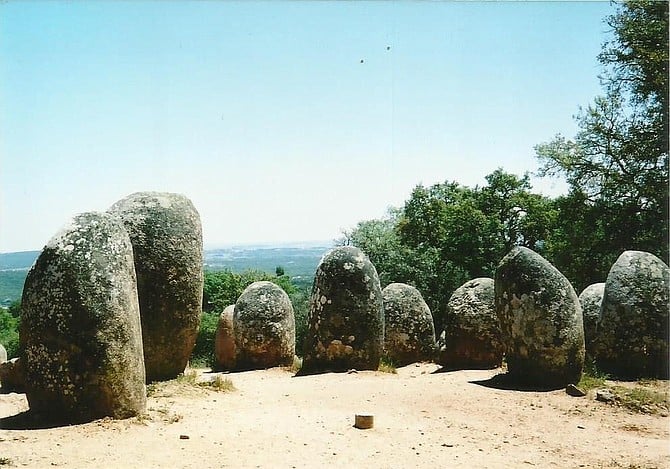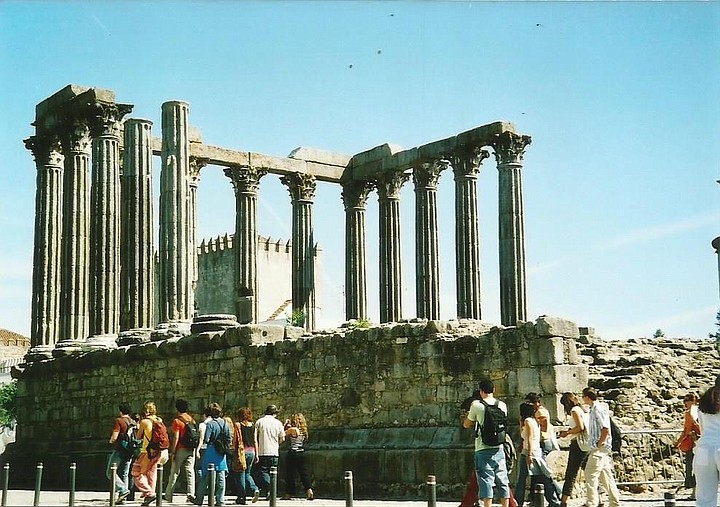 Facebook
Facebook
 X
X
 Instagram
Instagram
 TikTok
TikTok
 Youtube
Youtube

In Portugal’s southern Alentejo province, near the town of Evora, in the incongruous midst of a vast cork plantation, stands Portugal’s Stonehenge. It is called Os Almendres.

Around 6,000 years ago, for no obvious reason, the inhabitants of this arid inland plateau interrupted their hunting and gathering activities to somehow drag nearly 100 gigantic granite stones to a sloping dusty mound. They planted them vertically in roughly concentric circles and in a discernible, but inexplicable, sequence of heights.
The cork plantation the stones now stand among enhances the otherworldliness of the scene. Cork trees are gnarled and bent with small but abundant olive-drab leaves. A recently harvested one looks as much like a clipped French poodle as a tree can. Its lower trunk is shaved bald, but its top has thick grey furry bark and bushy foliage. Virtually no ground vegetation surrounds these trees.
If you travel the 12 miles from Evora to Almendres, you are at first stunned by how difficult it would have been for such an early civilisation to move these stones. But then, almost immediately, you confront a set of imponderable questions: “What were these people thinking? How could this have possibly been a worthwhile use of their limited resources?”
I am writing this in a pleasant Evora café near the ruins of a Roman temple while I recover from my visit to Almendres with a glass of Alentejo vinho branco. Around me sit several descendants of that curious rock-moving tribe. These particular descendants show no signs of putting down their espressos and beers to go look for really heavy stones to carry up a hill. That is not, however, to imply that they back down from other extraordinary challenges like consuming large steaks, boiled potatoes, fried eggs, sliced tomatoes, and lots of red wine at a mid-week summer lunch.

But I digress from the original question: Why are those rocks on that mound?
Since every unanswerable question deserves a definitive answer, archaeologists, theologians, astronomers, anthropologists and sex therapists have labored for years to provide one or more definitive answers.
Some of the various hypotheses are: The ancients arranged the stones in circles to help themselves observe astronomical movements so they could anticipate seasonal changes that would tell them when to plant their crops, organize their parties, or set their clocks to savings time.
Or, they shaved the tops off some of the stones to form a flat surface suitable for animal, vegetable or human sacrifices to appease the Necessaries to send rain, or game to hunt – or a successful football season, if the area’s current inhabitants’ passions are any indication.
Or, they selected certain stones for their phallic shape. It takes no Freudian analyst to see how one special stone could become a persuasive new product logo for Viagra. Therefore, the rock-laying people must have conducted fertility rites or Ibiza-style rave-ups during those ancient evenings.
All these reasons, and others, are possible. But whatever the reason, or lack of reason, for this rock-moving enthusiasm, Almendres makes a nice counterpoint to Stonehenge. No fences or guards regulate access to the Almendres stones because no one wants to paint ARSENAL RULES on them. No tea rooms, souvenir shops or tour coaches disturb their tranquillity because they aren’t world famous and they aren’t off the M3. And at the solstice, no white-clad Druids dance around them proclaiming the New World because the Portuguese just don’t do that religion.
In short, if you appreciate the special aura of Stonehenge despite the drawbacks of excessive tourism and other modern manias, then you should make the relatively short trip to Almendres the next time you find yourself in Lisbon with two days to spare.
If you do, you will stand in the hot still air of the dusty Alentejo plain, inside those timeless circles of systematically placed megalithic stones, surrounded by an eerie grey-green expanse of cork forest, and you will quietly wonder: “Why did they do it?”


In Portugal’s southern Alentejo province, near the town of Evora, in the incongruous midst of a vast cork plantation, stands Portugal’s Stonehenge. It is called Os Almendres.

Around 6,000 years ago, for no obvious reason, the inhabitants of this arid inland plateau interrupted their hunting and gathering activities to somehow drag nearly 100 gigantic granite stones to a sloping dusty mound. They planted them vertically in roughly concentric circles and in a discernible, but inexplicable, sequence of heights.
The cork plantation the stones now stand among enhances the otherworldliness of the scene. Cork trees are gnarled and bent with small but abundant olive-drab leaves. A recently harvested one looks as much like a clipped French poodle as a tree can. Its lower trunk is shaved bald, but its top has thick grey furry bark and bushy foliage. Virtually no ground vegetation surrounds these trees.
If you travel the 12 miles from Evora to Almendres, you are at first stunned by how difficult it would have been for such an early civilisation to move these stones. But then, almost immediately, you confront a set of imponderable questions: “What were these people thinking? How could this have possibly been a worthwhile use of their limited resources?”
I am writing this in a pleasant Evora café near the ruins of a Roman temple while I recover from my visit to Almendres with a glass of Alentejo vinho branco. Around me sit several descendants of that curious rock-moving tribe. These particular descendants show no signs of putting down their espressos and beers to go look for really heavy stones to carry up a hill. That is not, however, to imply that they back down from other extraordinary challenges like consuming large steaks, boiled potatoes, fried eggs, sliced tomatoes, and lots of red wine at a mid-week summer lunch.

But I digress from the original question: Why are those rocks on that mound?
Since every unanswerable question deserves a definitive answer, archaeologists, theologians, astronomers, anthropologists and sex therapists have labored for years to provide one or more definitive answers.
Some of the various hypotheses are: The ancients arranged the stones in circles to help themselves observe astronomical movements so they could anticipate seasonal changes that would tell them when to plant their crops, organize their parties, or set their clocks to savings time.
Or, they shaved the tops off some of the stones to form a flat surface suitable for animal, vegetable or human sacrifices to appease the Necessaries to send rain, or game to hunt – or a successful football season, if the area’s current inhabitants’ passions are any indication.
Or, they selected certain stones for their phallic shape. It takes no Freudian analyst to see how one special stone could become a persuasive new product logo for Viagra. Therefore, the rock-laying people must have conducted fertility rites or Ibiza-style rave-ups during those ancient evenings.
All these reasons, and others, are possible. But whatever the reason, or lack of reason, for this rock-moving enthusiasm, Almendres makes a nice counterpoint to Stonehenge. No fences or guards regulate access to the Almendres stones because no one wants to paint ARSENAL RULES on them. No tea rooms, souvenir shops or tour coaches disturb their tranquillity because they aren’t world famous and they aren’t off the M3. And at the solstice, no white-clad Druids dance around them proclaiming the New World because the Portuguese just don’t do that religion.
In short, if you appreciate the special aura of Stonehenge despite the drawbacks of excessive tourism and other modern manias, then you should make the relatively short trip to Almendres the next time you find yourself in Lisbon with two days to spare.
If you do, you will stand in the hot still air of the dusty Alentejo plain, inside those timeless circles of systematically placed megalithic stones, surrounded by an eerie grey-green expanse of cork forest, and you will quietly wonder: “Why did they do it?”
Comments